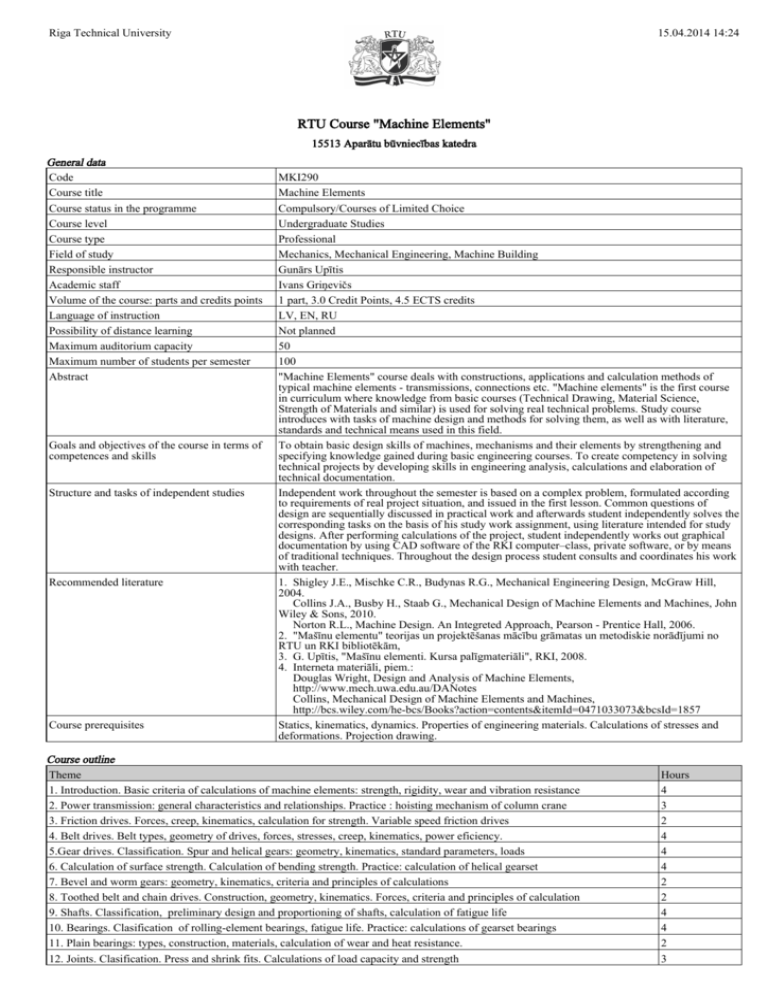
Riga Technical University
15.04.2014 14:24
RTU Course "Machine Elements"
15513 Aparātu būvniecības katedra
General data
Code
Course title
Course status in the programme
Course level
Course type
Field of study
Responsible instructor
Academic staff
Volume of the course: parts and credits points
Language of instruction
Possibility of distance learning
Maximum auditorium capacity
Maximum number of students per semester
Abstract
Goals and objectives of the course in terms of
competences and skills
Structure and tasks of independent studies
Recommended literature
Course prerequisites
MKI290
Machine Elements
Compulsory/Courses of Limited Choice
Undergraduate Studies
Professional
Mechanics, Mechanical Engineering, Machine Building
Gunārs Upītis
Ivans Griņevičs
1 part, 3.0 Credit Points, 4.5 ECTS credits
LV, EN, RU
Not planned
50
100
"Machine Elements" course deals with constructions, applications and calculation methods of
typical machine elements - transmissions, connections etc. "Machine elements" is the first course
in curriculum where knowledge from basic courses (Technical Drawing, Material Science,
Strength of Materials and similar) is used for solving real technical problems. Study course
introduces with tasks of machine design and methods for solving them, as well as with literature,
standards and technical means used in this field.
To obtain basic design skills of machines, mechanisms and their elements by strengthening and
specifying knowledge gained during basic engineering courses. To create competency in solving
technical projects by developing skills in engineering analysis, calculations and elaboration of
technical documentation.
Independent work throughout the semester is based on a complex problem, formulated according
to requirements of real project situation, and issued in the first lesson. Common questions of
design are sequentially discussed in practical work and afterwards student independently solves the
corresponding tasks on the basis of his study work assignment, using literature intended for study
designs. After performing calculations of the project, student independently works out graphical
documentation by using CAD software of the RKI computer–class, private software, or by means
of traditional techniques. Throughout the design process student consults and coordinates his work
with teacher.
1. Shigley J.E., Mischke C.R., Budynas R.G., Mechanical Engineering Design, McGraw Hill,
2004.
Collins J.A., Busby H., Staab G., Mechanical Design of Machine Elements and Machines, John
Wiley & Sons, 2010.
Norton R.L., Machine Design. An Integreted Approach, Pearson - Prentice Hall, 2006.
2. "Mašīnu elementu" teorijas un projektēšanas mācību grāmatas un metodiskie norādījumi no
RTU un RKI bibliotēkām,
3. G. Upītis, "Mašīnu elementi. Kursa palīgmateriāli", RKI, 2008.
4. Interneta materiāli, piem.:
Douglas Wright, Design and Analysis of Machine Elements,
http://www.mech.uwa.edu.au/DANotes
Collins, Mechanical Design of Machine Elements and Machines,
http://bcs.wiley.com/he-bcs/Books?action=contents&itemId=0471033073&bcsId=1857
Statics, kinematics, dynamics. Properties of engineering materials. Calculations of stresses and
deformations. Projection drawing.
Course outline
Theme
1. Introduction. Basic criteria of calculations of machine elements: strength, rigidity, wear and vibration resistance
2. Power transmission: general characteristics and relationships. Practice : hoisting mechanism of column crane
3. Friction drives. Forces, creep, kinematics, calculation for strength. Variable speed friction drives
4. Belt drives. Belt types, geometry of drives, forces, stresses, creep, kinematics, power eficiency.
5.Gear drives. Classification. Spur and helical gears: geometry, kinematics, standard parameters, loads
6. Calculation of surface strength. Calculation of bending strength. Practice: calculation of helical gearset
7. Bevel and worm gears: geometry, kinematics, criteria and principles of calculations
8. Toothed belt and chain drives. Construction, geometry, kinematics. Forces, criteria and principles of calculation
9. Shafts. Classification, preliminary design and proportioning of shafts, calculation of fatigue life
10. Bearings. Clasification of rolling-element bearings, fatigue life. Practice: calculations of gearset bearings
11. Plain bearings: types, construction, materials, calculation of wear and heat resistance.
12. Joints. Clasification. Press and shrink fits. Calculations of load capacity and strength
Hours
4
3
2
4
4
4
2
2
4
4
2
3
13. Threaded joints. Geometry of threads, parameters; Strength of threads, bolts and connections
14. Riveted and welded joints: types, calculation of strength. Practice: calculation of welded joint
15. Mechanical springs: types, parameters, calculations
Learning outcomes and assessment
Learning outcomes
Understanding of tasks and sequence of machine design process, specifics of technical calculations.
Ability to synthesize and analyze kinematical schemes of machines, to evaluate parameters of
drives.
Skills of selection, geometry determination and strength and fatigue life calculations of transmission
drives (frictional, belt, gear) and their elements (shafts, bearings). Skills to design technically wellgrounded joints of machine and structural elements (welded, threaded, interference fits).
Knowledge about engineering materials, standardization, factors influencing service life and
technological demands of manufacturing.
Ability to create constructions of machines and mechanisms, to perform sketch design, to work out
assembly and detail drawings. Basic skills of computer-aided design and engineering.
Study subject structure
Part
CP
1.
3.0
ECTS
4.5
Lectures
2.0
Hours per Week
Practical
1.0
Lab.
0.0
4
4
2
Assessment methods
Home work, individual verification and
correction of results, defence of the study
project.
Individual verification and correction of
results, defence of the study project. Exam.
Individual verification and correction of
results, defence of the study project. Exam.
Defence of the study project.
Test
Tests
Exam
*
Work






